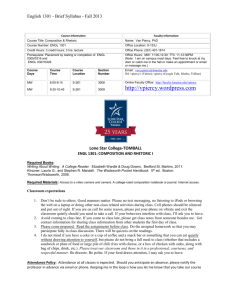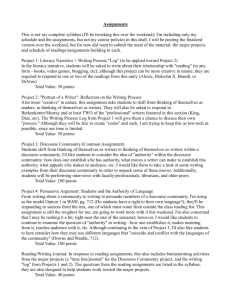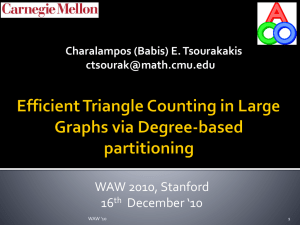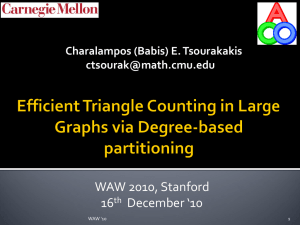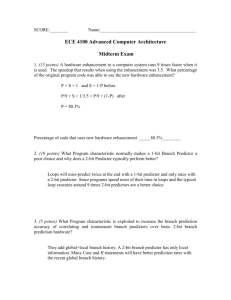pptx
advertisement
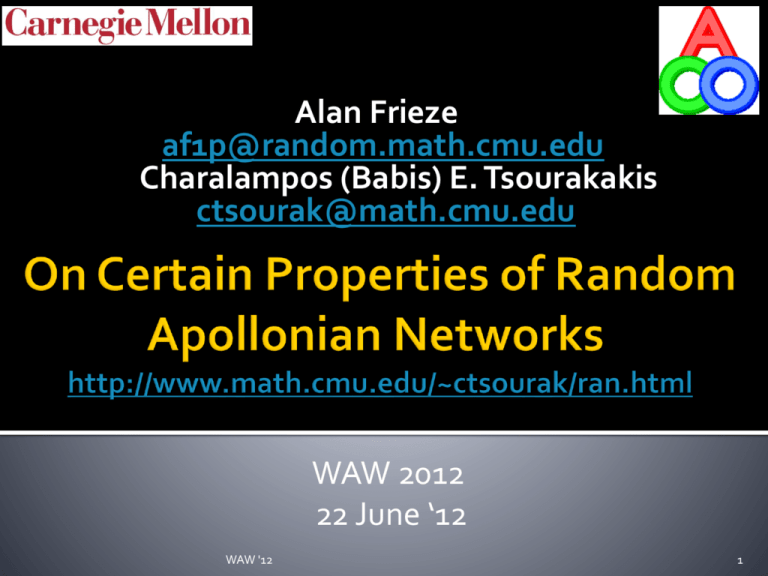
Alan Frieze af1p@random.math.cmu.edu Charalampos (Babis) E. Tsourakakis ctsourak@math.cmu.edu WAW 2012 22 June ‘12 WAW '12 1 Introduction Degree Distribution Diameter Highest Degrees Eigenvalues Open Problems WAW '12 2 Internet Map [lumeta.com] Friendship Network [Moody ’01] WAW '12 Food Web [Martinez ’91] Protein Interactions [genomebiology.com] 3 Modelling “real-world” networks has attracted a lot of attention. Common characteristics include: Skewed degree distributions (e.g., power laws). Large Clustering Coefficients Small diameter A popular model for modeling real-world planar graphs are Random Apollonian Networks. WAW '12 4 Construct circles that are tangent to three given circles οn the plane. Apollonius (262-190 BC) WAW '12 5 Apollonian Gasket WAW '12 6 Higher Dimensional (3d) Apollonian Packing. From now on, we shall discuss the 2d case. WAW '12 7 Dual version of Apollonian Packing WAW '12 8 Start with a triangle (t=0). Until the network reaches the desired size Pick a face F uniformly at random, insert a new vertex in it and connect it with the three vertices of F WAW '12 9 For any 𝑡 ≥ 0 Number of vertices nt =t+3 Number of vertices mt=3t+3 Number of faces Ft=2t+1 Note that a RAN is a maximal planar graph since for any planar graph 𝑚𝑡 ≤ 3𝑛𝑡 − 6 = 3𝑡 + 3 WAW '12 10 Introduction Degree Distribution Diameter Highest Degrees Eigenvalues Open Problems WAW '12 11 Let Nk(t)=E[Zk(t)]=expected #vertices of degree k at time t. Then: 𝑁3 𝑡 + 1 = 𝑁3 𝑡 3𝑁3 (𝑡) +1− 2𝑡+1 𝑘 1− + 2𝑡+1 𝑘−1 2𝑡+1 𝑁𝑘 𝑡 + 1 = 𝑁𝑘 𝑡 𝑁𝑘−1 𝑡 Solving the recurrence results in a power law with “slope 3”. WAW '12 12 Zk(t)=#of vertices of degree k at time t, 𝑘 ≥ 3 2 1 4 24 𝑏3 = , 𝑏4 = , 𝑏5 = , 𝑏𝑘 = 𝑘≥6 5 5 35 𝑘(𝑘+1)(𝑘+2) For t sufficiently large |𝐸 𝑍𝑘 𝑡 − 𝑏𝑘 𝑡| ≤ 3.6 Furthermore, for all possible degrees k Prob |Zk t − 𝐸 𝑍𝑘 𝑡 ≥ 10 𝑡𝑙𝑜𝑔(𝑡) = 𝑜(1) WAW '12 13 Degree Theorem Simulation 3 0.4 0.3982 4 0.2 0.2017 5 0.1143 0.1143 6 0.0714 0.0715 7 0.0476 0.0476 8 0.0333 0.0332 9 0.0242 0.0243 10 0.0182 0.0179 11 0.0140 0.0137 12 0.0110 0.0111 WAW '12 14 Introduction Degree Distribution Diameter Highest Degrees Eigenvalues Open Problems WAW '12 15 Depth of a face (recursively): Let α be the initial face, then depth(α)=1. For a face β created by picking face γ depth(β)=depth(γ)+1. e.g., WAW '12 16 Note that if k* is the maximum depth of a face at time t, then diam(Gt)=O(k*). Let Ft(k)=#faces of depth k at time t. Then, 𝐸 𝐹𝑡 𝑘 is equal to 𝑘 1≤𝑡1 <𝑡2 <..<𝑡𝑘 ≤𝑡 𝑗=1 1 1 ≤ 2𝑡𝑗 + 1 𝑘! 𝑡 𝑗=1 𝑡 1 2𝑗 + 1 𝑒𝑙𝑜𝑔 𝑡 ≤ 2𝑘 𝑘+1 Therefore by a first moment argument k*=O(log(t)) whp. WAW '12 17 WAW '12 18 WAW '12 19 WAW '12 20 WAW '12 21 WAW '12 22 WAW '12 23 Large Deviations for the Weighted Height of an Extended Class of Trees. Algorithmica 2006 Broutin Devroye The depth of the random ternary tree T in probability is ρ/2 log(t) where 1/ρ=η is the unique solution greater than 1 of the equation η-1-log(η)=log(3). Therefore we obtain an upper bound in probability 𝑑𝑖𝑎𝑚 𝐺𝑡 ≤ 𝜌log(𝑡) WAW '12 24 This cannot be used though to get a lower bound: Diameter=2, Depth arbitrarily large WAW '12 25 Introduction Degree Distribution Diameter Highest Degrees Eigenvalues Open Problems WAW '12 26 Let Δ1 ≥ Δ2 ≥ ⋯ ≥ Δk be the k highest degrees of the RAN Gt where k=O(1). Also let f(t) be a function s.t. 𝑓 𝑡 + ∞. Then whp 𝑡→∞ 𝑡 ≤ Δ1 ≤ 𝑡𝑓(𝑡) 𝑓(𝑡) and for i=2,..,k 𝑡 𝑡 ≤ Δ𝑖 ≤ Δ𝑖−1 − 𝑓(𝑡) 𝑓(𝑡) WAW '12 27 𝑡0 = log log(𝑓 𝑡 ) 𝑡1 = log(𝑓 𝑡 ) • • • • WAW '12 𝑡 Break up time in periods Create appropriate supernodes according to their age. Let Xt be the degree of a supernode. Couple RAN process with a simpler process Y such that 𝑋𝑡 ≥ 𝑌𝑡 , 𝑋𝑡0 = 𝑌𝑡0 = 𝑑0 Upper bound the probability p*(r)=Pr 𝑌𝑡 = 𝑑0 + 𝑟 Union bound and k-th moment 28 arguments Introduction Degree Distribution Diameter Highest Degrees Eigenvalues Open Problems WAW '12 29 Let 𝜆1 ≥ 𝜆2 ≥ ⋯ ≥ 𝜆𝑘 be the largest k eigenvalues of the adjacency matrix of Gt. Then 𝜆𝑖 = 1 ± 𝑜 1 Δi whp. Proof comes for “free” from our previous theorem due to the work of two groups: Chung Lu Vu Mihail WAW '12 Papadimitriou 30 𝑡1 = 𝑡 1/8 𝑡0 = 0 𝑡2 = 𝑡 9/16 S2 S1 …. 𝑡 S3 …. …. Star forest consisting of edges between S1 and S3-S’3 where S’3 is the subset of vertices of S3 with two or more neighbors in S1. WAW '12 31 Lemma: |𝑆 ′3 | ≤ 𝑡 1/6 This lemma allows us to prove that in F …. …. …. λ𝑖 𝐹 = 1 − 𝑜 1 WAW '12 Δi 32 Finally we prove that in H=G-F 𝜆1 Η = o λk F Proof Sketch First we prove a lemma. For any ε>0 and any f(t) s.t. 𝑓 𝑡 + ∞ the following holds 𝑡→∞ whp: for all s with 𝑓 𝑡 ≤ 𝑠 ≤ 𝑡 for all vertices 𝑟 ≤ 𝑠 then 𝑑𝑠 𝑟 ≤ 𝑠 WAW '12 𝜀+ 1 2 − 1 2 𝑟 . 33 Consider six induced subgraphs Hi=H[Si] and Hij=H(Si,Sj). The following holds: 3 𝜆1 𝐻 ≤ 𝑖=1 𝜆1 𝐻𝑖 + 𝜆1 (𝐻𝑖 , 𝐻𝑗 ) 𝑖<𝑗 Bound each term in the summation using the lemma and the fact that the maximum eigenvalue is bounded by the maximum degree. WAW '12 34 Introduction Degree Distribution Diameter Highest Degrees Eigenvalues Open Problems WAW '12 35 Conductance Φ is at most t-1/2 . Conjecture: Φ= Θ(t-1/2) Are RANs Hamiltonian? Conjecture: No Length of the longest path? Conjecture: Θ(n) WAW '12 36 Thank you! WAW '12 37

